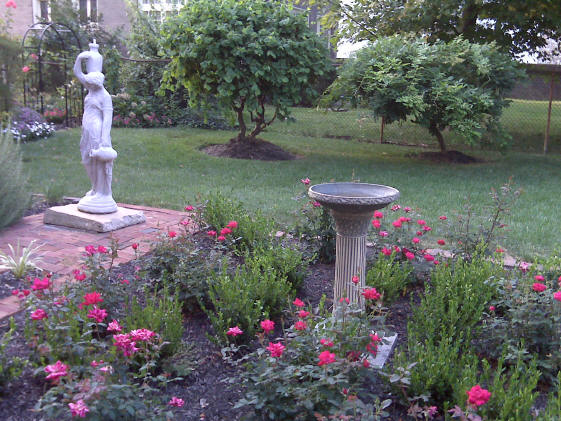 What is hardscape in the landscape? Hardscape is a term coined to represent anything in the garden or among plantings that isn't moving, green or growing. While there may be a more formal definition available, I believe this pretty
well explains the term.
What is hardscape in the landscape? Hardscape is a term coined to represent anything in the garden or among plantings that isn't moving, green or growing. While there may be a more formal definition available, I believe this pretty
well explains the term.
Hardscape can include benches or seating. It also refers to the addition of pavers, bricks or stone used to design a walkway. Hardscape can include fountains or statuary. Over the years I have collected a few decorative items that are special to me and have a home in a flower bed somewhere on our
property. My favorite is an old cupola with weathervane that I purchased at an antique shop years ago. It is wooden and weathered but fits in well among the flowers in my perennial garden.
At the opposite end of the spectrum is a formal garden with brick sidewalks, statues and birdbaths as shown in the photo taken at my favorite B&B in Ohio. Here the use of statuary serves to further punctuate the Greek Revival style of the structure of the B&B and carries forward that theme. My
weathered cupola at Lake Meade carries forward a more casual, cottage garden theme. Each example is a reflection of the gardener's own personal style and serves the same purpose - adding an element of interest to the plantings. I recommend defining a theme for your plantings with hardscape that carries that theme through
the landscape much like a theme established when decorating indoors.

Accent pieces for the out of doors are available just about anywhere today, as gardening has taken on an important role in helping us spend leisure time and extra money, thereby helping to boost a sagging economy. From garden centers to home improvement stores to department stores, there seems to be
a department somewhere dedicated to this growing American pastime. It goes without saying that the material of which your accent is made plays a part in your final decision. When it comes to lawn furniture, the selection is simply amazing. Even wicker furniture today is available in an outdoor, weather-resistant version.
A relatively new aspect of garden design is adding a walkway, patio or fire pit to the existing landscape that goes beyond traditional concrete installation. Stamped concrete is growing in popularity and is almost an art form in itself - there are many choices of colors and designs - while not
inexpensive it is permanent and an investment that is long-lasting.
Individual pavers, like bricks and stone, can be installed by the homeowner or a contracted professional; again, many choices, not cheap but long-lasting with a very attractive result. The most widely available paving materials fall into one of two broad categories: 1) quarried stone such as granite
or slate that is cut to shape upon installation and 2) composite materials that are molded when soft, then fired to dry, i.e. bricks and pavers. The choices are many and can be a bit overwhelming. Some are better suited than others to specific uses, so consulting with the installer and doing your homework prior to making a
choice is a must. The time spent in planning will make this investment the right choice for a lifetime.
Gravel is a good option for a small budget. It is easy to install but not as permanent. It requires a level of care not required of the traditional hardscape in that weeds will poke through and require maintenance to ensure a pleasing result. To avoid issues with shifting underfoot, consider gravel
labeled "1/4 inch minus"; anything larger could present a stability problem. Also, sharp, angular gravel will interlock as it settles to form a firm surface that will not shift. It helps to tamp the gravel after a 2-3 inch-deep layer is installed.
Remember, it is important to match the hardscape, like decorative accents among your plantings, to your home's style. More than any other hardscaping element, paving determines the character of your outdoor space. Adding your choice of plants to soften the edges of the hardscape will further define
your style and complement the investment you've made in paving. If there are steps and stone walls involved in your landscape design, think about using concrete as a base before applying the facing stone to ensure a long-lasting (and safe) result. However, if it is a rustic look you want to achieve, dry-laid walls without
mortar can be laid back at a slight angle to overcome gravity. No dry-stacked wall should exceed 3 feet in height to ensure stability.
Most importantly, plan any hardscape project that involves an investment of time and money in stone or paver installation carefully before moving forward. It truly is an investment that lasts a lifetime. Once a decision is made on the choice of materials and a landscape design, your easel is
established and your choice of shrubs and plants becomes your paintbrush. From the inception of the project through to final planting, keep your eyes peeled for those few decorative hardscape items you want to use to punctuate your project. Whether you choose seating for your outdoor space, fountains, statues or a
weathered birdbath, you are carrying forward a theme that began with the style and d